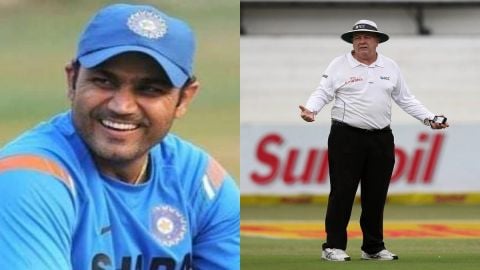Why Umpires & Rules Important For Cricket? - When Virender Sehwag Kicked A Ball For Four
How Sehwag kicked a ball for four while fielding and the cricketing world learnt the importance of the rules and umpires in the beloved game.

The beloved and famous game of cricket is loved and appreciated by its fans all around the world. The spectators in the stadiums as well as in front of their TV sets & indulge themselves in the game completely, letting the various aspects of the game alter their moods. Many of the fans may not understand the numerous laws and by-laws perfectly, and may even question the umpire's decision at times, but through this article, we'll look back at an incident where Sehwag purposedly kicked the ball to the boundary while fielding and how the umpires and the rules ensured fair play.
In the February of 2018, South Africa was on a tour to India for 2 tests and 3 ODIs. South Africa shocked the world as they won the first test at Nagpur. And not only did they win it, but the Proteas also won it by 6 runs and an innings, which left the Indian players and fans infuriated. Hashim Amla scored an unbeaten 253 runs in the first test while Jacques Kallis scored 173 runs.
Trending
Obviously, team India had to win the second test match to level the 2-match series and avoid a home test series defeat, the first in the last six years. South Africa were restricted to 296 runs in the first innings after opting to bat first. Hashim Amla was yet again the top scorer with 114 runs while Alviro Peterson scored 100 runs.
Wounded team India came out all guns blazing in their first innings, where as many as 4 batters - Virender Sehwag (165), Sachin Tendulkar (106), VVS Laxman (143*) and MS Dhoni (132*) played big knocks as India declared on 643/6. After this, South Africa crumbled to 284/9 in their second innings.
Team India were on the verge of victory with only two hurdles in sight - there were only 4 overs left to be bowled on the final day of the match. The second hurdle was Hashim Amla - who was in an impeccable form with already a double century and a century in the series, was still on the crease. India had to pick up 1 wicket to level the series, or it would have been only the third time since 1990 that India would have lost a home test series, with the last defeat 6 years ago in 2004 against Australia. To add to that, India and South Africa were really close and in a tussle for the top spot of the ICC test team rankings at the time.
All this adds up to only one thing - India desperately needed to win the test. The pressure was felt and was finally seen on the 5th delivery of the fourth to last over of the day. After Amla defended the first 4 balls, he hit the 5th ball towards the boundary for a quick single, making sure he keeps the strike in the next over. The ball had stopped just before the boundary rope, so close that the umpire would have gone upstairs to confirm. And if the ball wasn't touching, the fielder had to be very careful to save the boundary.

Virender Sehwag however, chasing the ball, leaned over near the boundary and kicked the ball over the boundary! With this, Sehwag wanted to keep Amla on strike on the last ball and then bring tail-ender Morkel on strike for the next over.

However, what happened next, neither Sehwag in his 20 years of cricketing experience knew nor anyone present at the ground or commentary box had an idea of - there were numerous rules, laws and by-laws which could have been enforced in this particular incident. At the time, there were 2000 revisions of MCC laws in place.
The first law which was applicable in this incident at the time was Law 19.7 - that if a boundary results from an overthrow or from a willful act of the fielder, the runs scored shall be - 1. any runs for the penalty, 2. The allowance for the boundary & 3. The runs were completed by the batters together with the run in progress if they had already crossed at the instant of the throw.
In this case, when Sehwag kicked the ball, the batters had already crossed while running. The second rule - Law 41.2 - a fielder can field the ball with any part of his body but if he doesn't wilfully field the ball then - 1. the ball would be declared as 'dead ball', 2. the umpire would award 5 runs to the batting side, 3. any runs completed by the batters would be given to the batting side and both captains would be informed and 4. both the umpires would report the occurrence as soon as possible to the governing body.
With two laws in place for the same incident, which law should be applied? There is another law for this, Law 42.2, which states that Umpires are to be the sole judge of fair and unfair play. Furthermore, if at any point during the game if any of the umpires feel any action to be unfair, they can intervene without an appeal.
In the case being talked about, neither side appealed for any unfair play or wrongdoing to the umpire. However, the umpire Steve Davis himself decided that this act by Sehwag amounted to unfair play, and applied the law 41.2 instead of 19.7. Consequently, Hashim Amla remained on the non-striker's end, South Africa were awarded 5 penalty runs and Sehwag was reported to the match referee. So, the rules which were laid much before this incident, ensured that Sehwag's trickery backfired in all ways.
However, the application of these rules ensured there were no speculations or unnecessary noise when India went on to win this test match with 9 balls remaining. India drew the series and maintained their home series record at home while maintaining their top spot in the ICC test team rankings as well.
Also Read: Scorecard
So as much as fans may hate rules and umpires at times, situations like these need a human to stand judge the grey areas, understand the human behavior and the game, and apply the suitable rules and penalties. Cricket needs umpires and their sense of judgement which can never be scrapped from the game.
